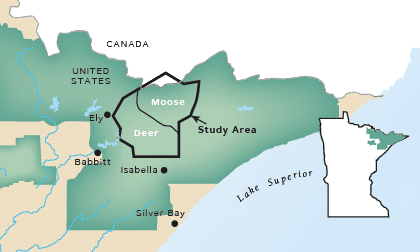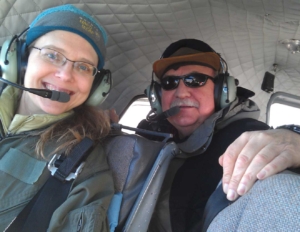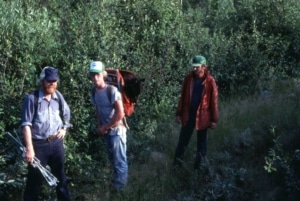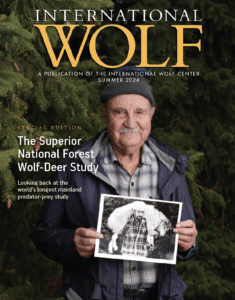The USGS Superior National Forest Wolf and Deer Research Project
An Overview:
The Wolf and Deer Research Project in the Superior National Forest (SNF) of northeastern Minnesota began in 1966 and continued into 2022 under the auspices of several organizations and agencies, most recently the U.S. Geological Survey. Its primary objective has been to determine and follow the annual wolf density in a 2,060 square-km (almost 800 square-mile) part of the east-central SNF and assess the causes of its trajectory over a long period.
Background
This research began in February1966 when Dave Mech, on his personal time, began examining and gathering specimens from wolf-killed deer in the east-central part of the SNF. In 1967, the U.S. Fish and Wildlife Service (USFWS) listed the wolf as an endangered species under the Endangered Species Preservation Act of 1966, and Dave continued this work under the auspices of Macalester College, using students as assistants, flying as an observer on routine Minnesota Department of Natural Resources (DNR) patrol flights and headquartering in a Minnesota DNR cabin in the SNF. Intermittently from early January through March 1967, he not only continued collecting specimens from wolf-killed deer but also aerially followed wolf tracks to observe and count wolves seen during the flights.
Other than on Isle Royale in nearby Lake Superior, the only wolf population in the 48 contiguous states was Minnesota’s, and little was known even about wolf natural history. In addition, the advent of radio-tracking was revolutionizing wildlife research. Dave was just completing his research-associate position, testing radio-tracking techniques for the University of Minnesota (UMN). Thus, much was to be gained by a radio-tracking study of Minnesota wolves.
In 1968, Dave became an assistant professor and research associate at Macalester College and continued the informal wolf work he had been doing, assisted by grants from various non-governmental organizations (NGOs). The research received considerable publicity, and Region 3 of the U.S. Fish and Wildlife Service and the North Central Forest Experiment Station (NCFES) of the U.S. Forest Service (USFS) offered radio-tracking collars for the project. The NCFES also provided the services of one of its biologists to assist during 1968-1969, as well as the use of its Kawishiwi Field Lab outside of Ely. (The project headquartered there through 2010.) The project began live-trapping and radio-collaring wolves in that same study area in 1968.
In 1969, Region 3 of the USFWS recruited Mech to become its wolf biologist, and in 1973, the project was transferred to the Endangered Wildlife Research Division of the Patuxent Wildlife Research Center. The NCFES then offered Dave an office in its building on the UMN campus, and the UMN offered an adjunct-professor position with its Department of Fisheries and Wildlife (now the Department of Fisheries, Wildlife and Conservation Biology) and the Department of Ecology and Behavior (now the Department of Ecology, Evolution and Behavior).
 Study Area
Study Area
As mentioned above, the main objective of the research was to determine the long-term trajectory of the wolf population in part of the SNF and the causes of any major changes. The study area was a 2,610 km2 area east of Ely, Minnesota, later reduced to a 2,060 km2 area (Fig. 1). It contained a region where wolves preyed primarily on white-tailed deer and another where they preyed primarily on moose and beavers. Another important characteristic of this study area is that it included not just wolf range accessible to humans but also the Boundary Waters Canoe Area Wilderness, which was much less accessible, particularly to wolf hunters and trappers.
SNF Field Work

Shannon Barber Meyer and Dave Mech aerially radio tracked wolves during the project.
When the project became a full-time endeavor, Mech recruited volunteer wildlife technicians and graduate students to assist with it. Eventually wildlife technicians were hired, and in the late 1970s, a full-time wildlife research biologist, Michael E. Nelson, was added. He, Mech, graduate students and volunteer technicians conducted the main field work through about the late 1980s when Mech had begun working on other wolf projects in Denali National Park, Ellesmere Island and Yellowstone. Nelson then assumed most of the SNF field work. He retired in 2011 and was replaced by Shannon Barber-Meyer, who continued the SNF field work.
When Congress transferred the Division of Wildlife Research from the USFWS to the National Biological Survey (later the National Biological Service), the Wolf and Deer Project transferred with it, and then to the U.S. Geological Survey. Concurrently, administration of the project moved from Patuxent to the Midcontinent Ecological Science Center, and then to Northern Prairie Wildlife Research Center.

Mike Nelson (left), wildlife technicians John Scott and Eric Gese (extreme right) prepare to radio track deer and wolves.
Funding for the research during the earlier years included major grants from NGOs as well as base funding from the respective Department of the Interior (DOI) agencies, with the USFS contributing the maintenance and utilities of Kawishiwi Field Lab of the NCFES into the 1990s. However, when the NCFES later eliminated its wildlife-research program, it terminated its support of Kawishiwi Field Lab, while allowing DOI researchers to remain headquartered there. In 2011, however, the NCFES (now the Northern Research Station) decided to decommission the Kawishiwi Lab buildings, so DOI researchers moved to a new U.S. Forest Service facility in Ely.
The Wolf and Deer Project’s primary study technique involved live-trapping, radio-collaring and aerially radio-tracking wolves and deer, and recording their numbers, locations, survival and mortality causes. Most of the tracking was conducted weekly via aircraft as conditions allowed, and during winter included observing and counting radioed wolves and their packmates, as well as aerially searching for non-radioed wolves and/or tracks in parts of the study area where no radioed wolves lived. The objective was to obtain a complete count of wolves in the study area annually. Since 2019, attempts have been made to obtain this count with non-invasive methods such as scat DNA collection, trail cams, citizen reports and snow tracking.
Results
 The project live-trapped 884 wolves during a total of 1,254 captures and recaptures and radio-tagged 778 of them. Also, 801 deer were caught during 1,068 captures and recaptures and most were radio-collared. Wolf counts were made each year from winter 1966-1967 through winter 2021-2022 (Fig. 2). Approximately 250 peer-reviewed books, monographs and articles were published about this research.
The project live-trapped 884 wolves during a total of 1,254 captures and recaptures and radio-tagged 778 of them. Also, 801 deer were caught during 1,068 captures and recaptures and most were radio-collared. Wolf counts were made each year from winter 1966-1967 through winter 2021-2022 (Fig. 2). Approximately 250 peer-reviewed books, monographs and articles were published about this research.
Although the basic objective of this research was to obtain the first long-term record of a mainland wolf-population trajectory worldwide, the technique used also allowed learning much about many other aspects of wolf ecology and behavior. Thus, hundreds of peer-reviewed scientific articles resulted, covering wolf natural history, movements, population changes, spatial organization, scent-marking, howling, dispersal, survival, mortality, diseases, nutritional condition, and relations with deer, moose and black bears. Others were published on deer movements, migrations, mortality, nutritional condition and natural history, as well as on Canada lynxes and martens, all in the same study area.
Every year for many years, 16 volunteer wildlife technicians gained experience with the project, and many of those, plus numerous Ph.D. and Masters’ students, eventually taught at universities, or became researchers or administrators with state or federal agencies. Many contributed significantly to wolf conservation, including the reintroduction of wolves to Yellowstone National Park and red wolves to Alligator River National Wildlife Refuge. One, Greg Smith, became director of Patuxent Wildlife Research Center.
The U.S. Geological Survey is the nation’s largest water, earth and biological science and civilian mapping agency. It collects, monitors, analyzes and provides scientific understanding of natural resource conditions, issues and problems.
 This article was originally published in the summer 2024 issue of International Wolf magazine, which is published quarterly by the International Wolf Center. The magazine is mailed exclusively to members of the Center.
This article was originally published in the summer 2024 issue of International Wolf magazine, which is published quarterly by the International Wolf Center. The magazine is mailed exclusively to members of the Center.
To learn more about membership, click here.

The International Wolf Center uses science-based education to teach and inspire the world about wolves, their ecology, and the wolf-human relationship.
